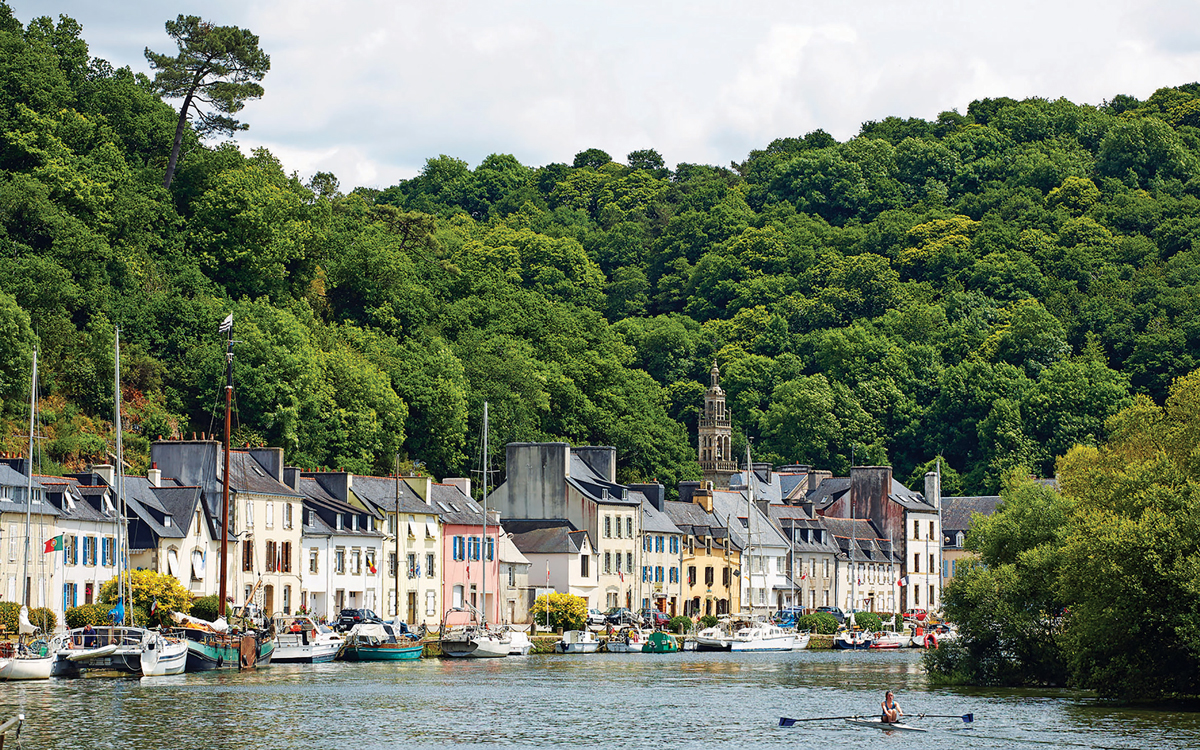Often overlooked for more popular cruising areas to the north and south, this section of coastline is one of France’s finest boating areas
Viviers de Térénez
On the south side of the Landévennec bend you’ll see a low waterside building with a covered veranda, just downstream from No 22 red buoy. This is the Viviers de Térénez, run by the Picart family, a haven of seafood where you can tuck into superlative crabs, lobsters, oysters and also smoked fillets of trout farmed in the estuary.
You might find an empty mooring on this bend, or anchor a little further upstream in the shallow muddy fringes near Térénez island. Then it’s worth taking the dinghy ashore to the Viviers for lunch. Be there soon after midday!
The Aulne slides through an almost forgotten valley, with vistas of looming hills and forest before the country becomes softer beyond Trégarvan. There are few signs of life above Le Passage village until the river curves south opposite a busy road.
The last two miles are quiet again, passing marshy saltings. Above the lock you creep under an impressive viaduct before reaching Port Launay’s restful quays, lined with very French houses. Moored comfortably here, you can take the dinghy further up to visit Châteaulin town.
Anse du Fret
A promontory called Île Longue juts out over a mile from the south side of the Rade de Brest and is surrounded on the chart by plenty of pecked purple lines and Entry Prohibited labels. This sensitive military zone is a French submarine base and you must keep well outside its cordon of protecting buoys.
However, it’s OK to enter the south-east corner of the bay, keeping close past Pointe de Lanvéoc and following the shore round to the shallow inlet known as Le Fret. You’ll see local boats moored opposite the quays of a small village.
For several days either side of neaps there’s enough depth to stay afloat at anchor here, or you may find an empty mooring. Le Fret is a charming, out of the way corner of the Rade, which most visiting boats pass by because of all the military warnings on the chart.
The Élorn River
The smaller Élorn River joins the Rade de Brest opposite Moulin Blanc, a secret water to explore by dinghy on the tide. The head of navigation is the old market town of Landerneau, where you can land near a low road bridge.
Beyond this modern crossing is the 15th-century Pont de Rohan, with quaint stone houses and shops over the river. In the 17th century, sailing barges drifted up to Landerneau carrying timber, flax and a special local granite from Logonna on the Aulne.
Round to Douarnenez
The Toulinguet channel leads close around Pointe du Toulinguet past the enticing white sands of Pen-Hat. Beyond a tail of humped rocks – Les Tas de Pois – head just east of south for seven miles before turning into Douarnenez Bay past Cap de la Chèvre.
This sheltered bight remains something of a cruising secret; partly because La Chèvre can look so austere that many boats hurry past. But behind the harsh headland lie 70 square miles of boating paradise fringed with pines and gorgeous beaches. At the head of the bay, soft rolling country lifts gradually inland.
Douarnenez is in the south-east corner of the bay at the mouth of the Pouldavid River. As you round Pointe de Leydé, the wooded hump of Île Tristan appears, with its neat lighthouse amongst the trees. On the west shore is Tréboul village and a sheltered strand where holidaymakers splash about. You’ll find Douarnenez town clustered above the east bank, beyond Île Tristan.
Douarnenez
The visitors’ pontoons are inside on the west bank, opposite Tristan and a drying spit linking it to the mainland. Just upstream is Tréboul marina, mostly for local boats. Behind the quays, Tréboul has plenty of shops and bistros, with lively Wednesday and Saturday markets. Douarnenez is separated from Tréboul by a long basin with another marina at its head. You can lock into this basin two hours either side of HW.
This old river port houses a superb maritime museum, the Port-Musée, where you can visit a stylish exhibition building and wander round old vessels moored alongside the museum. To reach this area, take a leisurely stroll around Tréboul harbour and cross a pedestrian bridge to the east bank.
Douarnenez was famous as a sardine port and hundreds of tan-sailed luggers once packed the quays in the old fishing harbour at Rosmeur, which is timelessly Breton with its tall houses, old-fashioned shutters and garret windows in steep pitched roofs.
The whiff of drying seaweed blends with mouthwatering restaurant aromas and a kind of nostalgia hangs over the ancient cobbles, as if Rosmeur was still waiting for the sails of the sardine fleet to appear round the point.












